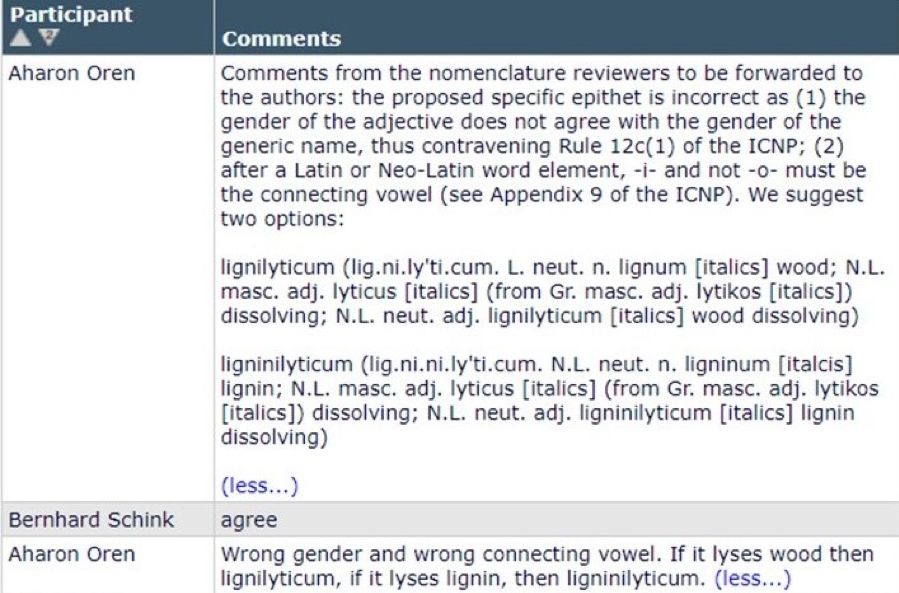How nomenclature reviews work and why are they important
Posted on March 3, 2020 by Aharon Oren
When a new genus or species of bacteria or archaea is discovered, it must be described and given a name. The rules of nomenclature are complex and newly-described prokaryotes must be named in-line with the guidelines set out in the International Code of Nomenclature of Prokaryotes (ICNP). Here Aharon Oren, nomenclature reviewer for the International Journal of Systematic and Evolutionary Microbiology discusses the importance of nomenclature.

I am based at the Hebrew University of Jerusalem, Israel, where I teach general microbiology and microbial ecology. My research centres on the microbiology of hypersaline environments. A recent interview gives further information about my background and interests.
In 2019, more than 1,100 manuscripts were submitted to the International Journal of Systematic and Evolutionary Microbiology (IJSEM). Over 900 of these were taxonomic descriptions in which authors proposed the establishment of one or more new species, often with new genera and higher taxa.
Binomial nomenclature was established in the 18th century by Linnaeus and is based on Latin and Greek. The rules of biological nomenclature are fixed in Codes of Nomenclature. For the prokaryotes this means the International Code of Nomenclature of Prokaryotes (ICNP). Every scientist who proposes new names of taxa of bacteria and archaea is therefore supposed to know and understand the rules of the ICNP and have a basic command of Latin and Greek. However, only a few of the authors of IJSEM papers have ever tried to read the Code (or are even aware of its existence), and even fewer have a basic understanding of the classical languages needed to correctly form names that are in agreement with the rules. Several articles and book chapters provide practical advice to authors on how to find suitable names for new genera and species. Some authors consult a nomenclature expert before submitting their manuscript. Still, we find nomenclature-related errors in at least half of the taxonomic descriptions submitted to the IJSEM.
Therefore, the journal uses a team of experts who provide nomenclature ‘quality control’ for all submitted manuscripts. Most of the daily work I do together with Professor Bernhard Schink of the University of Konstanz, Germany. Professor George Garrity of Michigan State University often assists on matters relating to the correct interpretation of the rules of the ICNP and other members of the IJSEM Editorial Board occasionally participate.
On a special nomenclature review forum in the Editorial Manager manuscript handling system, we discuss the new names proposed and nomenclature-related issues we encounter in the manuscripts. Each paper is reviewed by at least two nomenclature experts. The review process ends when we post a consensus opinion that the handling editor includes in the decision letter sent to authors after completion of the scientific reviews. We always try to explain to the authors why proposed names may be problematic, and we generally propose alternative names that abide by the rules. Below are two examples of such nomenclature review discussions for manuscripts in which names were proposed that violate the rules of the ICNP. When a revision is received, we also check whether our comments and recommendations have been correctly implemented in the new version of the manuscript.

A recent example of how the nomenclature ‘quality control’ system works: a screenshot of the discussions (to be read from bottom to top) on the nomenclature review forum about an IJSEM manuscript in which the epithet lignolytica was proposed for a new lignin-degrading species in a genus with a name of the neuter gender.

Another example of a screenshot of the nomenclature discussions (to be read from bottom to top) about a manuscript submitted to IJSEM describing a new genus and a new species for which the authors proposed the name Marinibacter nanhaiense.
Certain types of errors we encounter very often. Frequently we get adjectives used as specific epithets that do not agree in gender with the name of the genus, thus contravening Rule 12c(1) of the ICNP. As the name of the genus Staphylococcus is masculine, we have Staphylococcus aureus and not aurea (feminine) or aureum (neuter). Such gender problems are found in both examples shown in the screenshots. Some authors appear to believe that one can take any word from English or another modern language, add an ending that looks like Latin, and you have a name that can be published. Thus, we had proposals of epithets such as sealense (for a bacterium isolated from a seal) and pigeonensis (from a pigeon). In such cases that contravene Rule 6 and Recommendation 6, we point out that there are Latin equivalents (phoca = seal, columba = pigeon), and we proposed the genitive case phocae and columbae (‘of a seal’, ‘of a pigeon’). After many years of doing these nomenclature reviews, we are no longer surprised about weird and impossible names proposed in taxonomic papers. As the nomenclature of prokaryotes is not independent of botanical and zoological nomenclature (ICNP Principle 2), we also check whether newly proposed names of genera may already exist in botany or zoology.
We also assist editors and reviewers of a number of other journals that publish descriptions of new taxa of prokaryotes to ensure that the proposed names meet the requirements of the Code and can obtain standing in the nomenclature. Realising that in recent years, approximately 1400 new names of prokaryotic taxa were added to the list of names with standing in the nomenclature each year, it is clear that proper quality control means a lot of work. In a few cases, we overlooked errors, so a small number of problematic names were published in IJSEM. Still, we do our best to keep the nomenclature of prokaryotes in good order, and while doing so, educate manuscript authors and make them aware of the requirements for correctly naming new taxa.

